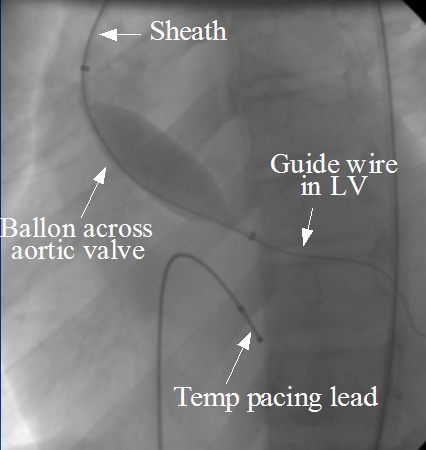Balloon aortic valvotomy (BAV)
Balloon aortic valvotomy (BAV)

Balloon aortic valvotomy was considered as a palliative procedure for those at high risk for aortic valve replacement. It can also be a bridge to aortic valve replacement.
A guide wire is introduced through the femoral artery into the aorta. The stenotic aortic valve is crossed, often requiring multiple attempts and a long time. A long sheath is introduced over the guidewire and through the sheath a Mansfield balloon is introduced and positioned across the aortic valve. Other types of balloons are Tyshak II, Z-Med and NuCLEUS-X, to name a few [1]. The balloon is manually inflated using a large syringe filled with dilute contrast. Care is taken to avoid melon seeding of the balloon into the aorta during inflation. If there is difficulty in maintaining the balloon across the aortic valve during inflation, temporary transvenous right ventricular pacing at high rate can reduce the cardiac output and give stability to the balloon. Balloon is deflated and the trans valvar gradient reassessed for success of the procedure. Repeated dilatations can be given if necessary. There is a small but significant risk of development of aortic regurgitation during the procedure, which if severe, can lead on to pulmonary edema. Another potential risk is embolization of calcific material from the aortic valve or ascending aorta into the cerebral circulation, which is fortunately very rare. Certain types of balloons can rupture while attempting to dilate a calcified valve as a palliative procedure. The balloon should be de-aired and filled with dilute contrast to avoid the chance of air embolism in case of balloon rupture during dilatation.
Palliative balloon dilatation prior to aortic valve replacement in moribund patients allow for improvement in heart failure and general condition of the patient so that they can be taken for elective valve replacement later with lower risk. With the onset of transcatheter aortic valve implantation (TAVI), also known as percutaneous aortic valve replacement (PAVR) or transcatheter aortic valve replacement (TAVR), palliative balloon dilatation alone is seldom needed as TAVI is a definitive procedure in sick patients with severe aortic stenosis.
Reference
- Keeble TR, Khokhar A, Akhtar MM, Mathur A, Weerackody R, Kennon S. Percutaneous balloon aortic valvuloplasty in the era of transcatheter aortic valve implantation: a narrative review. Open Heart. 2016 Dec 7;3(2):e000421.


